Employee Retention : our study findings
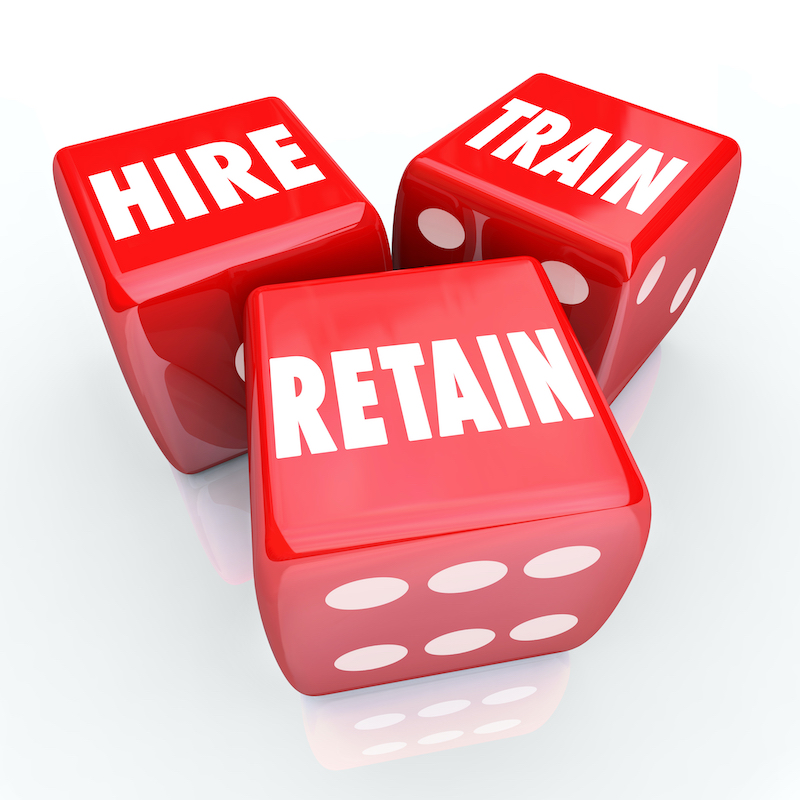
When thinking of the concept of attracting, motivating, and retaining employees, it is natural to look at it as a sequential set that starts from attracting talent, then motivating it, keeping it motivated to perform, and finally ensuring that the organization retains that talent. Nothing wrong with this way of comprehending the subject of employees association with an organization.
The Anchors
In the normal scheme of things, it’s also fine to assume that these three aspects happen to be in a sequence of going from the easiest to achieve to more difficult to achieve. i.e., Attracting talent is relatively easier and straightforward when compared to ‘motivating’ and keeping motivated the talent; which in turn is easier than keeping the talent engaged and retaining them in the longer term. Simplistically put, an employer can attract a prospective candidate by offering competitive pay and benefits and the project of hiring has a clear start and end point usually a few days to a few months, however to motivate the employee to perform at optimal levels, the employer needs not just the pay, benefits, and incentives but also have processes and systems to manage the performance through means of rewards and recognition. Here the timeline is the entire employment tenure of the employee unlike only a few months for attracting/recruiting; and finally when it comes to retention, besides the competitive pay, benefits, performance, and recognition programs, taking care of the overall well-being of the employee, which by the way, is not restricted to only when the employee is at the work-place, their development opportunities etc become more and more critical.
The above-listed five aspects are also famously referred to as the five elements of Total Rewards – employee pay, employee benefits, employee recognition, employee development, and employee well-being. In this article, we call it the five anchors for employee attraction, motivation, and retention.
The Influencers

Now that we have reconfirmed the key elements that help an employer attract, motivate and retain talent, let us dive deeper to find who all have an influence on each of these levers, and how one should manage these levers.
To understand this, we conducted a study amongst employees, managers, and top leaders of firms across industries and geographies. For ease of understanding, the findings from this study are captured in the three tables below showing the level of influence/control on the five levers of employee engagement by the three most important parties in an employee-employer employment situation:
- the Top Leadership of the organization (Top Management),
- the Human Resources function (Human Resources), and
- the immediate Line Manager of the employee (Line Manager).
We have further shown this from two perspectives that were surveyed:
- how it actually exists in a typical organization [based on facts] in table 1a.
- how it is perceived by the employees [employee perception] in table 1b.
Finally, Table 1c shows the consolidated summary.
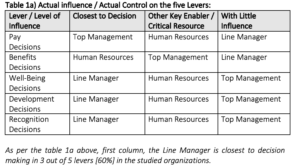
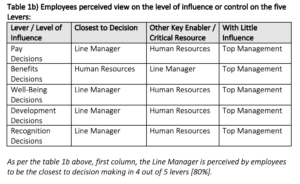
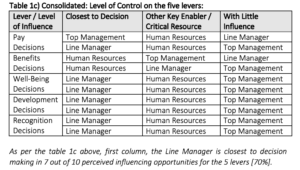
Our study findings complement, the well-known management thought that the Line Manager has the most influence when it comes to employee engagement and retention.
The Triggers

The five anchors of engagement have their own unique characteristics when it comes to the way they get triggered. While Pay and Benefits are more seen as hygiene factors that pinch an employee when they are ‘out-of-line’ or ‘uncompetitive’, the anchors of Well-being, Development and Recognition are more ubiquitous and these can get triggered at any time and for varied reasons. The below table summarizes when these five engagement elements get flared up to cause damage to the employee motivation or retention aspect. The last column describes the type of redressal needed to manage such flare-ups.
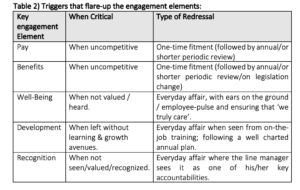
The Frequency
Finally, to be able to manage these anchors well, it is also important to establish the frequency of interventions needed to manage these. Ideally, a way for us to put these on our calendars to be able to manage them well. To understand and address this aspect, we have tabulated below, the frequency of action/decisions that are typically made around the five elements.
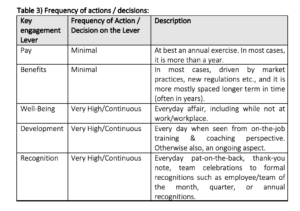
As captured above, while the two elements of Pay and Benefits are to be set right once (and then periodically), the other three elements of Well-being, Development and Recognition are to be managed continuously – every day! In fact, the lever of employee well-being is to be managed round-the-clock, even while the employee is not at the workplace.
Before going further, let us summarize the key findings as detailed above. So far, we have established the following :
- The Line Manager has the greatest influence (that too by a great margin) on employee engagement, motivation, and retention.
- the key aspects of employee Recognition, Development, and Well-being are to be managed on a continuous day-to-day basis (and not as a scheduled periodic calendar item).
Key Result Areas and Key Performance Indicators for Line Managers

Based on the above, we believe, that for a successful thriving organization, that attracts, motivates, and retains top talent, the Line Managers’ Key Result Areas (KRAs) should include the following three aspects of people management :
- Performance and Recognition
- Training & Development
- Well-being of employees
Accordingly, it is recommended that every Line Manager’s KPIs must include the following three elements (in some shape or form):
- Team Performance and Recognition they managed in their area of work for the assessment period.
- Team members’ development they directly influenced/managed for the assessment period
- Team members’ well-being they directly influenced/managed for the assessment period
Value your employees (and make sure every manager demonstrates this in their day-to-day work management)

While the performance evaluation period in organizations is typically aligned to the business activity cycle times – ranging from monthly (for project/sales jobs) to quarterly, half-yearly, or annually, it is recommended that for people managers, (which is all line managers in most cases), the KRA review period should not be more than 3 months to build a great workplace.
Business Leaders need to keep furthering the idea that people are the biggest asset of their organization; people are sensitive, they are to be always handled with care; people management is an ongoing regular affair, and finally, people attraction, motivation, and retention is the foremost responsibility of management (to be read, the respective line Managers).
The CEO, the CXOs, and the CHRO need to make sure that they check in regularly with their managers on these people’s KRAs/KPIs, making sure their employees are engaged – one employee, one manager at a time.
Retention of key talent is one of the main challenges that has resurfaced with full force post-pandemic, and clearly, it is a priority for companies and their managers. Therefore, obtaining buy-in from line managers should be easy these days. After all, it is the Line Managers that suffer the most when an employee leaves.
Finally, as the old adage goes, treat others (to be read., your team members) the way you would want to be treated (to be read., by your manager and the broader organization). This applies to all of us, starting from the business leaders / CEO to the Line Managers to the last supervisor on the shop floor.
